|
TennisOne Lessons Balanced Strokes, Game Symmetry and The Two-Handed Backhand Doug King I generally try to write and talk about "stroke “principles” or concepts that I think apply to all strokes, and therefore I don’t usually single out one individual stroke. However I want to acknowledge that the various strokes have inherent differences built into them and therefore they have their own “nature.” So in this article I will address what I consider the ideal two-handed backhand. I will also talk about the various “natures” of the strokes (primarily the one-handed forehand and the two-handed backhand). In doing so, we will also look at the concepts of symmetry and uniformity and the roles they play in developing a stroke “philosophy,” and touch on the ways that we approach stroke development. Finally we will look at stroke “balance,” and talk about ways to develop the “aspects” that are necessary to create a technically complete stroke. I have often said the modern game of torque and leverage is based more and more upon a two-handed stroking model. Although I am not a two-handed player I am a strong believer that this is a great way of learning as it corrects most of the common faults that plague many developing players. At the same time I recognize that the two-handed approach can have limitations (and I am not referring to reach). I do not want to get into a discussion about which is better, a single or double-handed backhand but I would suggest they have different stroking aspects (which we will look at further on). John McEnroe and Steffi Graff had great one-handed backhands because they used the stroke in a manner that was perfectly suited to the stroke that they had. And although Sampras and Federer are held up as supports for the one-handed backhand position, it cannot be denied that the backhand was/is their relative weakness. Thus it is important to acknowledge that stroke technique is not the only thing that determines the overall effectiveness of a stroke. How the stroke is utilized within an overall game is equally, if not more, important. Still one should understand what stroke technique is best suited to a specific style or result, whether that is power, spin, touch, or finesse. And a reasonable approach is to strive for a technique that establishes a strong platform, allowing a player to develop all stroke aspects of spin, power, and control. Stroke Construction and Stroke Balance A good stroke is comprised of many elements but two fundamental aspects are structure and flexibility. As with the human body, the stroke is built upon stability and mobility, strength and flexibility. And similar to the human body, a stroke must have "bones," structure, or "form" as well as flexibility, mobility, and speed. The larger muscle groups generally provide the stability or "bones" of the stroke, while the arms and hands (the smaller muscle groups) create mobility and speed. The challenge in stroke developments to integrate these two aspects into a well orchestrated, "balanced" stroke. In previous articles I have discussed how the stroke resembles an ocean wave. A wave has structure, stability, and “form,” while at the same time it has flexibility, mobility, and speed. Although not every wave is exactly the same, all waves do follow a specific formula of development or construction. The parts of the wave are put together in a very specific way and yet the wave itself is very fluid and flexible in all of its individual parts. The parts of the wave work in total synchronicity with each other and yet the parts are very independent of each other. In this way the wave is in certain ways a total paradox unto itself. It is constantly changing and yet is always the same. It is totally fluid and yet it adheres to strict form. This is the same kind of “paradox” that makes a perfect stroke so difficult to attain. We must keep structure to the stroke and yet at the same time it must be totally fluid and able to change. The parts of a stroke must be totally linked and yet at the same time be able to operate independent of each other. And every stroke must follow the same formula of construction and yet be able to have its own individual identity. These two stroke aspects, stability and mobility, are best represented in two specific things; one is posture - and the other is grip. The posture of the body represents the large muscle groups and provides the stability, and fittingly, the "bones" or form of the stroke. Meanwhile the grip relates to the use of the smallest muscle groups, the arms and hands, and is responsible for the speed, flexibility, and finesse elements of the stroke. In my opinion these are the two most tangible aspects of "technique" that define a stroke. Of course there are other aspects of timing, touch, and rhythm that are critical but are much more subtle aspects to define. Not surprisingly these two aspects of posture and grip are very closely intertwined, as we shall study later. Inherent Stroke Natures We can see that these two stroke aspects, stability and fluidity, are more emphasized in various strokes (volleys, serves, one-handed or two-handed groundstrokes, etc…) We can also say that the aspects of stability and fluidity are also more or less pronounced in various body and personality types. For example, the two-handed backhand groundstroke tends to be much more “body oriented” due to its close connection to the body. With both hands on the racquet, the stroke is more “locked” into the body and thus there is inherently more emphasis put on this “body” aspect of the stroke. The stroke tends to be very stable and solid as the arms and body naturally work in unison. The two-handed backhand also restricts the freedom of movement of the arm and therefore puts more demands on body rotation and precision of footwork. Simply put, there is more of a restriction on the arm swing in a two-handed stroke and therefore the body must compensate in the equation. The one-handed forehand, by contrast,tends to be much more arm and wrist oriented. In a way it is less stable than the two-hander as the arm has more of a tendency to “drift” or swing away from the body. This tendency to drift away from the body creates timing issues as the arm and body tend to get out of sync and the stroke gets longer and slower. The forehand, however, is more flexible, more adaptable, and mobile. It can make compensations more easily and it can create swing speed with more ease, and independent of the body. Thus we have a basic stroke profile or stroke nature based upon these orientations. On the positive side, the forehand is typically the more flexible, adaptable, and quicker stroke, but also it tends to be a more erratic. It tends to be both more threatening and more temperamental. Players can play aggressive shots from more varied positions (on the run, slightly late, etc...), while they may struggle with consistency, and the stroke may "go off" or lose form more frequently. The two-handed backhand is much more reliable but may lack the range of fire power or mobility that the forehand possesses. The two-handed backhand may do much better in a return of serve capacity for example, since it is more compact, has fewer timing issues and is better suited to returning power rather than generating power. However, it may have trouble generating power (handy on slow balls, high balls, or balls on the run). Also its less flexible nature may leave it more vulnerable to a strong attack. In addition, the two-handed backhand tends to be hit with less spin since the forehand is more capable of generating swing speed because of the looser arm/hand action. These, of course, are general “tendencies” and not at all hard realities. It is important to realize that although the forehand may lack structure, this aspect can certainly be developed and for some players it may come very naturally. The same can be said about the two-handed backhand; that although it is not “naturally a “loose” stroke, this is something that can be learned and it may be something that comes very easily or naturally for some. In fact, I think that it is fair to assume that despite these general tendencies there is no reason why the forehand and two-handed backhand cannot share the same construction blueprint. That is, the two-handed backhand can be approached as a single handed non-dominant forehand – and at the same time, the forehand can be approached as a two-handed non-dominant backhand. In either case, we can see that by integrating tendencies of the other the result can be a more balanced stroke. Let’s see how this is possible. Borrowing to Create Balance If we start with the premise that the single handed forehand and the two-handed backhand have certain inherent strengths and weaknesses , and we set about creating a well balanced stroke that has the aspects of both good structure, stability, and consistency, as well as good mobility, speed, and touch, then I think that a good way to proceed is to adopt the strengths inherent in one stroke and apply them to the other. We can do this by first realizing that there is logically no real difference between the two strokes. The racquet is the same on the right side of the body or the left, the ball is the same, and the person is the same. Therefore it is reasonable to try and apply the same principles from one side to the other. For example, we have often been told that the two-handed backhand is actually a non-dominant forehand with the other hand simply along for the ride. I completely agree with this statement and would go so far as to say that whatever grip or hand position the dominant hand takes on the two-handed backhand, it is always the non-dominant hand that is the stronger hand.In other words, if you are right-handed and you play a two-handed backhand, regardless of where you put your right hand on the two-hander or what you may feel, your left hand will always be the stronger hand in the stroke. This is just simple physics. The right hand will still have a role in generating torque on the ball, and where you place your right hand will impact that role, but it is the hand that is in the back of the racquet that is always taking the brunt of the force. With this being said, a very effective and complimentary way to practice the two-hander is to practice it occasionally as a left handed forehand. What this will do is to encourage a loosening of the grip on the racquet and help to develop more flexibility and feel in the arms, wrists, and hands. Remember that the tendency of the two-handed stroke is towards compactness and structure so it can get a bit stiff or what we call “too pushy.” It tends to be more of a challenge to get the two-handed stroke to loosen up, so this practice will help to develop that aspect. Correspondingly, a good way to develop more structure or form on the single-handed forehand is to occasionally practice it as a two-handed backhand. To do this, I would recommend that you put your dominant hand (right hand for a right-hander) above the left hand to play it as a two-handed left-handed backhand. This will help you develop a more compact swing path that will help with timing, footwork, and body rotation. In other words it will keep the arm from getting too long or “too whippy” and help you to get your body more properly engaged in the stroke.
While these “borrowing” practices mentioned above, can help develop aspects of the stroke, they represent only a minor part of the overall practice regimen, but this practice can unlock valuable insights and feels into parts of the stroke that need development in order to put the finishing touches on your stroke. Adding this element of practice may help you to develop better balance in your strokes and symmetry in your game. This approach can also help you to see the game not as individual strokes but as a more integrated and logical “system.” This can prove crucial in developing a stroke philosophy which can be important in determining how you should go about developing your game technically, that is, deciding what kind of a stroke to adopt, be it a grip, a stance, a backswing, or a follow-through. This consideration may have more relevance for tennis teachers who should be able to explain why strokes are technically built a certain way, but on the other hand, everyone must at some time become their own coach. The point is that it is very difficult to know what changes to make, if any, and even if you are taking the suggestion of a coach you will inevitably have to ask yourself if the stroke or change being suggested is really right for you. How does one know? Usually we simply try things out and see how they feel and how they work. This is certainly part of the process but it is not the only consideration. For example, a Continental grip on the serve is almost universally accepted as the most effective grip but almost no one feels comfortable with it at the start. Not only does it initially feel awkward, it generally produces a weaker and less accurate result. It will however, force the practitioner into habits that may prove positive down the road, especially at higher levels of the game. Therefore, we cannot simply rely on what feels good or what produces the best results at the moment in order to achieve the goals we set for ourselves. This is where a stroke philosophy is important as it can provide much needed direction. There should be an underlying reason why we do things a certain way and these reasons are stroke “principles.” These principles should apply to all situations equally and there should be no exceptions. That is not to say that all individual strokes are the same – far from it – since the truth is that the situations we encounter while we play are in a constant state of change. But for me, it is these “principles”, even more so that what people “feel”, that form the basis of why I suggest or prefer a certain style of stroke, which we will now detail on the two-handed backhand.
The Two-Handed Backhand Instead of detailing every aspect of the two-handed backhand, I will address the most common technical variations. Basically I will try to present my idea typical two-handed backhand form, using this platform of a principled stroke theory as a guide (meaning there should be little significant difference from the forehand). Also note that this will be presented in right-handed orientation.
Grip I think a great deal of the stroke form and style evolves from the grip. I like to see a full Eastern forehand grip on the left hand. This would put the heel pad and base index knuckle somewhere between bevel 3 and 4. This is also sometimes called the “modern Eastern” grip and is somewhere between a more classic Eastern and semi-Western. I also strongly prefer to see a change of grip in the right hand. I like to see the base index knuckle and the heel pad rest between bevel 2 and 3. A combination of grip change in both hands creates a very powerful leveraged position with the hands and arms strongly aligned well in front of the body. Look at players such as Hingis, Agassi, Dementieva, Sharapova, and Nadal as examples of this type of grip. Consequently, all of the above players will follow a very similar stroke pattern largely based upon this grip. Backswing As with the forehand, I like to see the racquet lifted and kept to the front of the body at the initial turn of the shoulders. It is almost as though the racquet is kept up and in front, as though marking the contact point, as the shoulders and body are turned back. This immediately puts the body into the proper “sideways to the net and behind the hands” orientation before the racquet is actually pulled back. It also allows the backswing to vary depending upon how much time there is and how big a backswing is appropriate.
From this position the player has the ability to use a very minimal backswing or to lengthen the backswing, whereas when the racquet is pulled back quickly the size of the backswing is committed immediately and may not always be appropriate.
Also, I like to see the racquet head kept well above the wrist at the start of the backswing, creating a mild loop. This is for two reasons; one is because this is the natural position of the racquet head in the “ready position” and other than a quick grip change there should be very little hand action (pulling the racquet back, dropping the racquet, etc…) until after the body has turned. This is because the hands should be kept relaxed and should react passively to the larger muscle groups. Secondly, keeping the racquet head up at this point is the most efficient use of gravity as a power source, as later in the stroke all that the hands have to do is to let the racquet head fall and flow to the ball with minimal force required from the body. This allows the weight shift to be saved a bit later and used on the contact rather than prior to the contact. Some players will let the racquet drop almost immediately in the backswing, even before the shoulders have turned, most notably Venus Williams, or use a straighter backswing, like Nalbandian or Davydenko, all of whom have great backhands. But what you may notice that even when they initially drop the racquet to start the backswing, later on in the stroke they will lift the racquet to make a loop action somewhere in the backswing.
So in reality, dropping the racquet head quickly doesn’t necessarily insure getting under the ball more than keeping the racquet head up longer in the backswing and using a loop action . . In any case, we rarely see the racquet head dropped to initiate the backswing on the forehand therefore symmetry would dictate that the same should apply on the backhand. Posture As I mentioned earlier, the grip one uses is very much interrelated to the body posture of the stroke. This is because the grip will determine the position of the hands in relation to the body at contact and it will also strongly influence the angle of the racquet face. A more Continental grip on the left (non-dominant hand) will put the contact more to the side of the body and further back in the stance. The Continental grip will also tend to leave the racquet face more open, causing the body to lean more forward in order to square the racquet face on contact. This, in my opinion, can create a tendency to take the ball slightly late and is more stressful on the body. We see this Continental grip and forward tilting body posture in a number of women, but rarely among the men( Michael Chang being an exception.)
Compare this to Dementieva or Sharapova or Nadal. All of these players use more grip change creating a more closed face and a more severe angle between the racquet and the forearms. This both positions the racquet head farther in front of the body at contact and also allows the body to stay more balanced, or ”erect” (neutral), throughout the stroke. Notice the body posture is more “square” or straight at contact and I believe that this is a more stable and powerful position for contact. This body /hand position is also consistent with the posture shown in other sports like baseball and golf at contact. Follow-Through The follow-through is quite natural and should finish with the racquet over the opposite shoulder with the butt of the racquet pointing at the target, as is the elbow of the left arm. There is actually less variation on the backhand in both the backswing and the follow-through, than on the forehand. This is because the two-handed stroke has a more restrictive swing pattern than the forehand and, therefore, the range of stylistic variations among two-handed backhands is much narrower than on the one-handed counterpart. Taking this observation to its natural conclusion, we see the most swing variations in the stroke that has the most swing freedom, and that is the serve. The actual position of the follow through will vary naturally with the amount of speed or force that is applied to the stroke. When more swing speed is required for either more spin or ball speed, the follow-through will naturally be longer, whereas if less speed is require then the follow-through will tend to be shorter, as is the case with many returns of serve, approach shots, and some passing shots.
Stance Although I don’t usually put a strong emphasis on stance, I do think that it is worth noting that the two-handed backhand is typically played with a more neutral stance whereas the forehand is played more out of an open stance. We see that some players, most notably the Williams sisters, are making the open stance backhand more common so that it mimics the footwork of the forehand. Although I recognize this as an important option, I would consider it to be a dangerous trend. Rather than trying to emulate the footwork of the forehand and adopting it to the two-handed backhand, I think it should be the other way around. I believe that the footwork on the two-handed backhand should be more the model for the forehand, in that there should be less “open stance” stroking and more squaring up into “neutral stance” hitting, at least as a “normal” and desired approach.
The reason is that the neutral stance puts the emphasis on getting properly aligned for the contact of the ball. Remember, the stroke alignment is a “sideways to the net orientation,” just like baseball, golf, and all other sports. The “ready position” we are in while waiting for the ball is not technically a “stroking position” but more of a “waiting position” (waiting to see if it is going to be a forehand or backhand). Whereas an argument for the open stance is that it allows us to recover more quickly, our real concern regarding stance should be about what stance allows us to execute the stroke with the most surety. I see a trend towards getting a bit lazy with the footwork as the open stance becomes more and more common, now becoming the norm on the backhand. The “open stance” argument that I commonly hear (i.e. quicker recovery) would be the same as a baseball hitter using an open stance to hit a baseball because it gives him a quicker step to first base. Well that may sound reasonable but if it undermines our ability to make solid contact with the ball, it seems we are getting our priorities mixed up. Remember, there is nothing to “recover” from if you miss the shot, so your first priority is to get your feet positioned in a way to maximize successful stroke execution, recovery should be a secondary consideration. Still, the forehand may be naturally suited to a more open stance approach, as a one-handed stroke is able to create backswing independent of the body more than the two-handed stroke. Andbeing a one-handed stroke, it is definitely more of a “one sided stroke.” In any case it is important to have a number of options for both strokes when it comes to stances, but in terms of trying to borrow the open stance from the forehand and making that the standard footwork for the backhand, I see this as a dangerous and counterproductive trend. Two-Handed Backhand Overview Although we see a few technical differences on the two-handed backhand, there are fewer stylistic variations than on the forehand. This is because the more compact nature of the stroke does not readily allow for deviations. However there are two basic stroking styles that I see as common; one is defined by a more complete grip change and an upright body position (Hingis, Dementieva, Sharapova, Agassi, Nadal), and a second in which we see a more pronounced forward body lean and a mild or no grip change (Azarenka, Safina, Chang). The first style commonly includes a looped backswing in which the racquet is kept up and forward as the body turns, followed by a more continuous flowing arm/racquet action out to the ball. The forward leaning stroke more often is characterized by a quicker and more severe (often straight) backswing. We also see variations or combinations, such as Nalbandian or Davydenko, where there is a straight take back of the racquet but a relatively upright body position throughout the stroke (not the forward lean into the ball). With the upright players we see a more complete grip change incorporated by a straight take-back. Even in these cases of a straight take-back we will still see a loop but it is usually more delayed and therefore a quicker, less noticeable loop. Summary Although the two-handed backhand is often described as an “opposite handed forehand,” the truth is that the one-handed forehand and the two-handed backhand have different “natures.” The two-handed backhand is more structured and body based, while the forehand is much more flexibility/mobility and hands based. Still it is very useful to think of the two strokes as mirror images of each other as a well balanced stroke is actually comprised of a well proportioned mix of both of these qualities. In fact, it can be very useful to practice techniques based upon this theory, i.e. hitting two-handed forehands to develop more structure on the forehand side, and hitting one handed non-dominant forehands to develop more flexibility on the two-handed backhand side.
Adopting this attitude and insight will also help to create a sense of continuity and symmetry throughout your game. You will be less inclined to see the game as a series of independent strokes, but more as a unified set of common feels and techniques based upon common principles. You will be better able to identify the various strengths and weaknesses of different techniques and be able to utilize these techniques in an appropriate and effective way. In turn, by better understanding the principles and mechanics upon which the game is built, you will reduce confusion, increase confidence, and have a better means of directing your own development as a player. Your comments are welcome. Let us know what you think about Doug King's article by emailing us here at TennisOne.
Doug is one of the country's foremost tennis teaching innovators. Founder of Acceleration Tennis, a revolutionary teaching system, King is leading the way in reinterpreting the traditional tennis model. Doug King is currently Director of Tennis at Meadowood Napa Valley ( www.meadowood.com ), a Relaix Chateau Resort in St. Helena , CA . For more information on Acceleration Tennis please email Doug King at dking@meadowood.com. |
|||||||||||||||||||
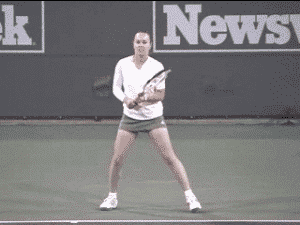
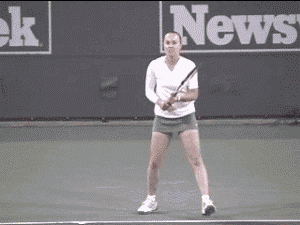
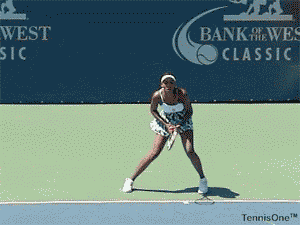
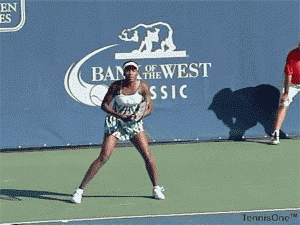
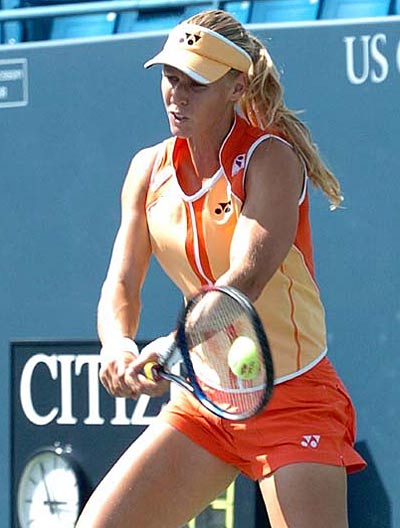
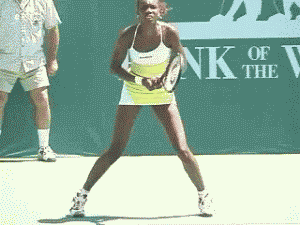
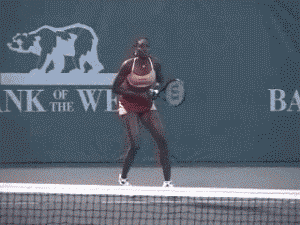
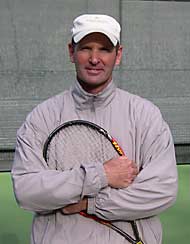
 Doug King studied with legendary tennis coach Tom Stow and was a
former California State Men's Singles Champion
and the former number one men's player of Northern California.
Doug King studied with legendary tennis coach Tom Stow and was a
former California State Men's Singles Champion
and the former number one men's player of Northern California.